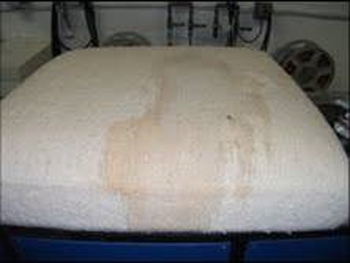Jim Pemberton
MB Exclusive.
- Joined
- Oct 7, 2006
- Messages
- 12,064
- Name
- Jim Pemberton
Your Customer Says "You Ruined My Furniture!"
(..and she's right!)
by Jim Pemberton - Fabric Pro Specialist
Cleaners often contact me asking for cleaning procedures and formulas to correct browning. While there are both products and procedures that may remove the brown stain, it's also important to remember, that the physical changes that cause browning, and what is done to correct it, actually damage the fabric!

How Browning Damages Furniture Fabrics:
When browning occurs, the changes that occur in the fiber that cause it to turn brown weakens the fiber. This damage may not be detectable, but it is important to understand that browning is a destructive process, and one that should be avoided at all costs.
Three Points You Must Never Forget:
#1 - Occasionally you will be asked to correct browning that was caused by another cleaner. Remember that you are not simply removing soil when you remove browning and therefore leaving a fabric that is nearly "good as new". You are instead restoring the cosmetic appearance of a fabric that has been damaged. Make this clear to your customer before you do anything else. You are not, and should not be held responsible for any outcome.
#2 - Remember: The correction of browning is nearly always more destructive! The only way to correct the browning without causing further fiber damage will be to use a browning agent that uses a mild acid only, rather than one that contains bleaches or reducing agents.
#3 - If the browning is severe: You will need to use aggressive correction products, especially oxidizing agents, and these will cause further deterioration of the fabric, and repeated applications of such browning removal formulas will weaken the fabric enough that it will split during use in the near future.
The bottom line is this: Browning is a condition that is completely preventable if you use the correct cleaning agents and proper cleaning procedures. If a fabric has been abused and is heavily soiled, you must choose carefully if you wish to clean such a fabric when browning might be possible after cleaning, as both the browning and your attempts to correct it are more destructive to the fabric than most are aware.
Encourage your customers to have delicate natural fiber fabrics cleaned when they are only lightly soiled. In that way you can use cleaning processes that are safe for the fabric, and will leave the fabric both clean and will extend, rather than shorten, its useful life.
If you'd like to learn more about how to clean natural fiber fabrics without the risk of browning, join me at our next Fabric Pro Workshop, which is primarily a “hands on” workshop with a focus on problem solving and problem prevention when cleaning natural fiber fabrics.
For more information on the Fabric Pro Workshop, CLICK HERE
***************************************************
Class size is very limited for personal attention purposes,
so register today.
(..and she's right!)
by Jim Pemberton - Fabric Pro Specialist
Cleaners often contact me asking for cleaning procedures and formulas to correct browning. While there are both products and procedures that may remove the brown stain, it's also important to remember, that the physical changes that cause browning, and what is done to correct it, actually damage the fabric!

How Browning Damages Furniture Fabrics:
When browning occurs, the changes that occur in the fiber that cause it to turn brown weakens the fiber. This damage may not be detectable, but it is important to understand that browning is a destructive process, and one that should be avoided at all costs.
Three Points You Must Never Forget:
#1 - Occasionally you will be asked to correct browning that was caused by another cleaner. Remember that you are not simply removing soil when you remove browning and therefore leaving a fabric that is nearly "good as new". You are instead restoring the cosmetic appearance of a fabric that has been damaged. Make this clear to your customer before you do anything else. You are not, and should not be held responsible for any outcome.
#2 - Remember: The correction of browning is nearly always more destructive! The only way to correct the browning without causing further fiber damage will be to use a browning agent that uses a mild acid only, rather than one that contains bleaches or reducing agents.
#3 - If the browning is severe: You will need to use aggressive correction products, especially oxidizing agents, and these will cause further deterioration of the fabric, and repeated applications of such browning removal formulas will weaken the fabric enough that it will split during use in the near future.
The bottom line is this: Browning is a condition that is completely preventable if you use the correct cleaning agents and proper cleaning procedures. If a fabric has been abused and is heavily soiled, you must choose carefully if you wish to clean such a fabric when browning might be possible after cleaning, as both the browning and your attempts to correct it are more destructive to the fabric than most are aware.
Encourage your customers to have delicate natural fiber fabrics cleaned when they are only lightly soiled. In that way you can use cleaning processes that are safe for the fabric, and will leave the fabric both clean and will extend, rather than shorten, its useful life.
If you'd like to learn more about how to clean natural fiber fabrics without the risk of browning, join me at our next Fabric Pro Workshop, which is primarily a “hands on” workshop with a focus on problem solving and problem prevention when cleaning natural fiber fabrics.
For more information on the Fabric Pro Workshop, CLICK HERE
***************************************************
Class size is very limited for personal attention purposes,
so register today.

